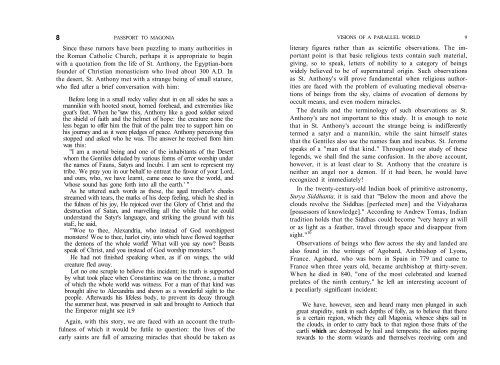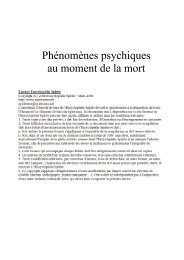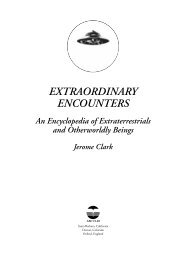You also want an ePaper? Increase the reach of your titles
YUMPU automatically turns print PDFs into web optimized ePapers that Google loves.
8 PASSPORT TO MAGONIA<br />
Since these rumors have been puzzling to many authorities in<br />
the Roman Catholic Church, perhaps it is appropriate to begin<br />
with a quotation from the life of St. Anthony, the Egyptian-born<br />
founder of Christian monasticism who lived about 300 A.D. In<br />
the desert, St. Anthony met with a strange being of small stature,<br />
who fled after a brief conversation with him:<br />
Before long in a small rocky valley shut in on all sides he sees a<br />
mannikin with hooted snout, horned forehead, and extremities like<br />
goat's feet. When he "saw this, Anthony like a good soldier seized<br />
the shield of faith and the helmet of hope: the creature none the<br />
less began to offer him the fruit of the palm tree to support him on<br />
his journey and as it were pledges of peace. Anthony perceiving this<br />
stopped and asked who he was. The answer he received from him<br />
was this:<br />
"I am a mortal being and one of the inhabitants of the Desert<br />
whom the Gentiles deluded by various forms of error worship under<br />
the names of Fauns, Satyrs and Incubi. I am sent to represent my<br />
tribe. We pray you in our behalf to entreat the favour of your Lord,<br />
and ours, who, we have learnt, came once to save the world, and<br />
'whose sound has gone forth into all the earth.' "<br />
As he uttered such words as these, the aged traveller's cheeks<br />
streamed with tears, the marks of his deep feeling, which he shed in<br />
the fulness of his joy, He rejoiced over the Glory of Christ and the<br />
destruction of Satan, and marvelling all the while that he could<br />
understand the Satyr's language, and striking the ground with his<br />
staE, he said,<br />
"Woe to thee, Alexandria, who instead of God worshippest<br />
monsters! Woe to thee, harlot city, into which have flowed together<br />
the demons of the whole world! What will you say now? Beasts<br />
speak of Christ, and you instead of God worship monsters."<br />
He had not finished speaking when, as if on wings, the wild<br />
creature fled away.<br />
Let no one scruple to believe this incident; its truth is supported<br />
by what took place when Constantinc was on the throne, a matter<br />
of which the whole world was witness. For a man of that kind was<br />
brought alive to Alexandria and shewn as a wonderful sight to the<br />
people. Afterwards his lifeless body, to prevent its decay through<br />
the summer heat, was preserved in salt and brought to Antioch that<br />
the Emperor might see it.9<br />
Again, with this story, we are faced with an account the truthfulness<br />
of which it would be futile to question: the lives of the<br />
early saints are full of amazing miracles that should be taken as<br />
VISIONS OF A PARALLEL WORLD 9<br />
literary figures rather than as scientific observations. The important<br />
point is that basic religious texts contain such material,<br />
giving, so to speak, letters of nobility to a category of beings<br />
widely believed to be of supernatural origin. Such observations<br />
as St. Anthony's will prove fundamental when religious authorities<br />
are faced with the problem of evaluating medieval observations<br />
of beings from the sky, claims of evocation of demons by<br />
occult means, and even modern miracles.<br />
The details and the terminology of such observations as St.<br />
Anthony's are not important to this study. It is enough to note<br />
that in St. Anthony's account the strange being is indifferently<br />
termed a satyr and a mannikin, while the saint himself states<br />
that the Gentiles also use the names faun and incubus. St. Jerome<br />
speaks of a "man of that kind." Throughout our study of these<br />
legends, we shall find the same confusion. In the above account,<br />
however, it is at least clear to St. Anthony that the creature is<br />
neither an angel nor a demon. If it had been, he would have<br />
recognized it immediately!<br />
In the twenty-century-old Indian book of primitive astronomy,<br />
Surya Siddhanta, it is said that "Below the moon and above the<br />
clouds revolve the Siddhas [perfected men] and the Vidyaharas<br />
[possessors of knowledge]." According to Andrew Tomas, Indian<br />
tradition holds that the Siddhas could become "very heavy at will<br />
or as light as a feather, travel through space and disappear from<br />
sight." 10<br />
Observations of beings who flew across the sky and landed are<br />
also found in the writings of Agobard, Archbishop of Lyons,<br />
France. Agobard, who was born in Spain in 779 and came to<br />
France when three years old, became archbishop at thirty-seven.<br />
When he died in 840, "one of the most celebrated and learned<br />
prelates of the ninth century," he left an interesting account of<br />
a peculiarly significant incident:<br />
We have, however, seen and heard many men plunged in such<br />
great stupidity, sunk in such depths of folly, as to believe that there<br />
is a certain region, which they call Magonia, whence ships sail in<br />
the clouds, in order to carry back to that region those fruits of the<br />
cartli which arc destroyed by hail and tempests; the sailors paying<br />
rewards to the storm wizards and themselves receiving corn and





